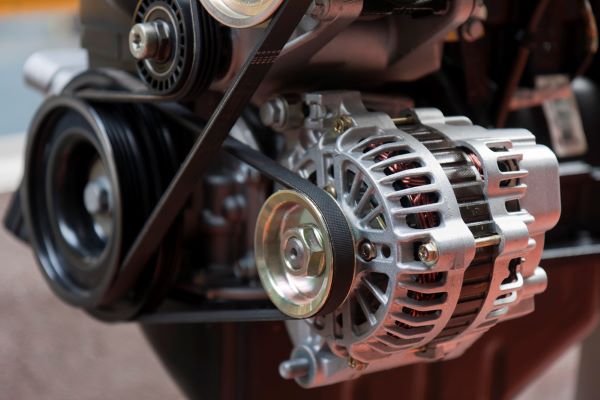If the car battery continues dying, you might be wondering whether you are dealing with a bad alternator vs. bad battery. Thankfully, you can learn how to test an alternator by disconnecting the battery. While this isn’t always the recommended way, it’s helpful if you need to learn how to check a car battery without a multimeter.

Our steps will help you identify if you have a bad battery vs. bad alternator and will even discuss some of the top symptoms. We can also dive deeper into the charging system by looking at how to tell if battery cables are bad, leading to a poor charge.
Table of Contents
Signs of a Bad Car Battery vs. Alternator
When the car battery dies, many of the symptoms are the same as when you have a defective alternator, making it difficult to troubleshoot which one is causing problems. Here are a few symptoms you might notice.
Battery Warning Light
Whether the battery is dying or the alternator is failing, you should see a warning light on the dashboard. Depending on what model you drive, the illuminated message might be generic, causing you some confusion. If you aren’t sure what the lights mean, you can reference your owner’s manual.
Dimming Headlights
When there isn’t enough charge on the battery or the alternator is failing, the headlights are going to get dim. The headlights can also start to flicker when there isn’t enough power. When everything is working as it should, you would see a bright, constant illumination from the lights.
Dead Car Battery
Your car battery requires power from the alternator to charge. If you have taken your vehicle for a drive and end up with a dead car battery, your alternator isn’t working. In fact, it can lead to the car dying while you are driving.
Accessory Malfunctions
The alternator is helping to run all of the electrical accessories while the engine is on. If you start experiencing problems with the radio, power windows, dashboard lights or air conditioning, this vital charging part might be to blame.
Burning Smells with Strange Sounds
You should always use your senses to determine if something is wrong with the car. Burnt rubber or hot wires should cause alarm along with strange sounds that are coming from underneath the hood. Many times, these problems are caused by excessive amounts of friction.
Stalling Engine
When the alternator fails to charge the battery, you might not have enough power to keep the engine running. This can cause issues starting the vehicle and keeping it running as the battery dies.
How to Test Alternator by Disconnecting Battery: Step-by-Step Directions
If you are noticing any of the above signs of a bad car battery vs. alternator, you are ready to start some diagnostic steps. You can disconnect the battery while the car is running to check an alternator.
- Park in an open, safe area.
- Open up the hood.
- Start the vehicle. You might have trouble with this step if the battery is dead and the alternator is failing.
- Once the car is running, disconnect the battery.
If the vehicle continues running as it was, there’s nothing wrong with the alternator. You might have an issue with the battery itself or the connections. If it stops running, you should replace the alternator.
Here is an illustration of how this test would work.
Why You Should Avoid This Method for Testing a Bad Alternator vs. Bad Battery
The steps outlined above are simple enough to do but also not advised. Removing the battery cable couldn’t be any easier to perform, but it’s also a risky maneuver.
For starters, the test can be ineffective. When you pull the battery cable to test an alternator, you risk killing the regulator.
Additionally, the results aren’t that reliable. If the alternator is producing some power, it can still run the engine, even if it is on its way out. Therefore, you could assume that your alternator is in good shape when it isn’t.
The last thing you want to do is fry some internal components because you wanted to take a short cut. So, how should you test the alternator?
Using a Battery Alternator Tester
The right way to check the condition of your car’s charging system is to use a battery alternator tester. We recommend getting a high-quality multimeter and following these simple steps instead.
- Turn on your vehicle, but keep all of the accessories powered off.
- Take a reading of the battery terminal voltage.
- Turn on the accessories in the vehicle.
- Take another reading with your voltmeter.
In most cases, readings of 14V and 13V indicate that the alternator is operating as it should. If you get a different reading, it could be a sign that the alternator is bad or starting to fail.
If you need some illustration of what these steps look like, check out this helpful video.
What Causes an Alternator to Go Bad?
Over time, you can expect the alternator to fail. However, some other issues can lead to premature wear.
Leaking Fluid
When power steering fluid or engine oil leaks onto the alternator, it can malfunction. The simple way to prevent this is to regularly check the system for leaks and repair them immediately.
Poor Driving Habits
The way you use your vehicle affects how the alternator works. If you spend a lot of time idling the car with your accessories on, you are putting more wear on the alternator. It also causes excessive amounts of heat, which causes the alternator to fail prematurely.
Moisture Exposure
The alternator is located near the engine and it can be affected by water. Whether you live in a humid area that creates a lot of condensation or your system leaks water onto the alternator, both conditions can lead to early wear.
Replace the Alternator: DIY Steps
If you have some mechanical knowledge and basic tools, you can change your alternator yourself. We recommend giving yourself two hours and brushing up on any important information in the service manual.
- Take the time to save memory settings on your preset electronics. Otherwise, you will need to reconfigure the time, preset stereo stations and more.
- Disconnect the negative battery cable.
- Loosen up the belt tensioner.
- Remove the serpentine belt.
- Take off the wiring connectors or harness.
- Remove the alternator.
- Put the new alternator in place, being careful to fit it just right with all of the bolt holes.
- Put the replacement belt on.
- Ensure the tension is just right.
- Reconnect the negative battery cable.
At this point, you may want to run through the alternator checks once again to ensure everything is reading right. If it’s not, the alternator probably wasn’t your issue.
If you need further guidance, here is a video illustrating how to change an alternator.
Bad Battery vs. Alternator FAQ
What does the alternator do?
The alternator is a vital part of the vehicle’s charging system. It supplies the vehicle with DC power. It is also responsible for supplying a charge to the car battery while the engine is running. Basically, it is powered by a drive belt and creates electrical energy.
Can a car run with a bad alternator?
It’s possible that the vehicle will continue to run even while the alternator is failing. However, the alternator is responsible for providing a charge to the battery and giving power to the spark plugs needed to run the engine. When the alternator starts to go bad, the engine might not get the power it needs, causing it to stall.
How long does an alternator last?
The battery is responsible for starting the car and lasts around five years under normal conditions. On the other hand, the alternator is needed to keep the battery charged. On average, this vital part will last about seven years, under normal conditions, or about 100,000 to 150,000 miles.
How long will a battery last with a bad alternator?
In many situations, the battery could last 30 minutes or less. However, if the battery has a full charge and you don’t have an excessive load on it, you could get up to two hours out of it. Once the vehicle is running, don’t turn it off or it might not restart.
What should I do if the alternator keeps going bad?
Once you install a new alternator, it shouldn’t go bad. If your second alternator goes bad shortly after the installation, you have bigger problems. There could be a short circuit in the system or a bad ground connection from the block. Before you put on another alternator, resolve the condition that is causing the defect first.
Conclusion
If your vehicle is having trouble running, you want to know whether it is the battery or alternator to blame. By following our steps to testing an alternator by disconnecting the battery or by using an alternator tester, you can determine the cause of your problems for a quick fix. Don’t neglect the health of your charging system or you could be left stranded down the road.
